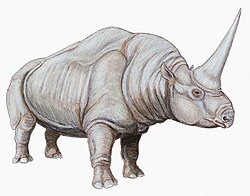Pseudhipparion
Appearance
| Pseudhipparion | |
|---|---|

| |
| Pseudhipparion retrusum skull, Museo di Paleontologia di Firenze | |
| Scientific classification | |
| Domain: | Eukaryota |
| Kingdom: | Animalia |
| Phylum: | Chordata |
| Class: | Mammalia |
| Order: | Perissodactyla |
| Family: | Equidae |
| Subfamily: | Equinae |
| Tribe: | †Hipparionini |
| Genus: | †Pseudhipparion Ameghino, 1904 |
| Species | |
| |
Pseudhipparion is an extinct genus of three-toed horse endemic to North America during the Miocene.[1][2][3][4][5] They were herding animals whose diet consisted of C3 plants.[6][7][8][9][10][11][12] Fossils found in Georgia, Florida, Oregon, Montana, Kansas, Texas, Nebraska, and South Dakota indicate that it was a lightweight horse, weighing up to 90 pounds (40 kilograms).[13][14][15][16][17][18][19][20][21] In 2005, fossils were unearthed in Oklahoma.[22] Seven species of Pseudhipparion are known from the fossil record which were very small, following the trend of Bergmann's rule.[23]
References
[edit]- ^ Hulbert, R. C.; Czaplewski, N. J.; Webb, S. D. (2005). "New records of Pseudhipparion simpsoni (Mammalia, Equidae) from the late Hemphillian of Oklahoma and Florida". Journal of Vertebrate Paleontology. 25 (3): 737. doi:10.1671/0272-4634(2005)025[0737:NROPSM]2.0.CO;2. S2CID 129964988.
- ^ S.D. Webb, Richard C. Hulbert; Hulbert (Jan 1986). "Systematics and evolution of Pseudhipparion (Mammalia, Equidae) from the late Neogene of the Gulf Coastal Plain and the Great Plains". Rocky Mountain Geology. 24: 237–272. doi:10.2113/gsrocky.24.special_paper_3.237. ISBN 0941570029.
- ^ Baskin, Jon A. (1991). "Early Pliocene Horses from Late Pleistocene Fluvial Deposits, Gulf Coastal Plain, South Texas". Journal of Paleontology. 65 (6): 995–1006. Bibcode:1991JPal...65..995B. doi:10.1017/S0022336000033308. ISSN 0022-3360. JSTOR 1305832. S2CID 131564565.
- ^ Hulbert, Richard C. (1987). "Late Neogene Neohipparion (Mammalia, Equidae) from the Gulf Coastal Plain of Florida and Texas". Journal of Paleontology. 61 (4): 809–830. Bibcode:1987JPal...61..809H. doi:10.1017/S0022336000029152. ISSN 0022-3360. JSTOR 1305291. S2CID 130745896.
- ^ Killingsworth, Stephanie R.; MacFadden, Bruce J. (2024-01-24). "Species occurrences of Mio-Pliocene horses (Equidae) from Florida: sampling, ecology, or both?". Paleobiology. 50 (2): 364–375. doi:10.1017/pab.2023.35. ISSN 0094-8373.
- ^ Feranec, Robert S.; MacFadden, Bruce J. (2006). "Isotopic Discrimination of Resource Partitioning among Ungulates in C3-Dominated Communities from the Miocene of Florida and California". Paleobiology. 32 (2): 191–205. Bibcode:2006Pbio...32..191F. doi:10.1666/05006.1. ISSN 0094-8373. JSTOR 4096995. S2CID 86226812.
- ^ MacFadden, Bruce J.; Solounias, Nikos; Cerling, Thure E. (1999). "Ancient Diets, Ecology, and Extinction of 5-Million-Year-Old Horses from Florida". Science. 283 (5403): 824–827. doi:10.1126/science.283.5403.824. ISSN 0036-8075. JSTOR 2897243. PMID 9933161.
- ^ MacFadden, Bruce J. (2000). "Cenozoic Mammalian Herbivores from the Americas: Reconstructing Ancient Diets and Terrestrial Communities". Annual Review of Ecology and Systematics. 31 (1): 33–59. Bibcode:2000AnRES..31...33M. doi:10.1146/annurev.ecolsys.31.1.33. ISSN 0066-4162. JSTOR 221724.
- ^ Forsten, Ann (1973). "Abnormal Enamel Morphology in Fossil Equid Teeth". Journal of Mammalogy. 54 (1): 255–258. doi:10.2307/1378887. ISSN 0022-2372.
- ^ Maguire, Kaitlin Clare; Stigall, Alycia L. (October 2009). "Using ecological niche modeling for quantitative biogeographic analysis: a case study of Miocene and Pliocene Equinae in the Great Plains". Paleobiology. 35 (4): 587–611. doi:10.1666/0094-8373-35.4.587. ISSN 0094-8373.
- ^ Passey, Benjamin H.; Cerling, Thure E.; Perkins, Michael E.; Voorhies, Michael R.; Harris, John M.; Tucker, Shane T. (March 2002). "Environmental Change in the Great Plains: An Isotopic Record from Fossil Horses". The Journal of Geology. 110 (2): 123–140. doi:10.1086/338280. ISSN 0022-1376.
- ^ MacFadden, Bruce J. (2008-08-27). "Geographic variation in diets of ancient populations of 5-million-year-old (early Pliocene) horses from southern North America". Palaeogeography, Palaeoclimatology, Palaeoecology. Investigating climates, environments and biology using stable isotopes. 266 (1): 83–94. doi:10.1016/j.palaeo.2008.03.019. ISSN 0031-0182.
- ^ "19A; Two Small Primitive Horses from Taylor County". Exploring Georgia's Fossil Record & Our History of Paleontology. Archived from the original on 2021-06-27. Retrieved 2021-06-27.
- ^ Shotwell, J. Arnold (1956-06-01). "Hemphillian Mammalian Assemblage From Northeastern Oregon". GSA Bulletin. 67 (6): 717–738. doi:10.1130/0016-7606(1956)67[717:HMAFNO]2.0.CO;2. ISSN 0016-7606.
- ^ KONIZESKI, R. L (1957-02-01). "Paleoecology of the Middle Pliocene Deer Lodge Local Fauna, Western Montana". GSA Bulletin. 68 (2): 131–150. doi:10.1130/0016-7606(1957)68[131:POTMPD]2.0.CO;2. ISSN 0016-7606.
- ^ David Webb, S.; Hulbert, Richard C., "Systematics and evolution ofPseudhipparion(Mammalia, Equidae) from the late Neogene of the Gulf Coastal Plain and the Great Plains", Vertebrates, Phylogeny, and Philosophy, Laramie, WY: University of Wyoming, pp. 237–272, ISBN 0-941570-02-9, retrieved 2025-03-30
- ^ Diffendal, R. F. (1987), "Ash Hollow State Historical Park", North-Central Section of the Geological Society of America, Geological Society of America, pp. 29–34, ISBN 0-8137-5403-8, retrieved 2025-03-30
- ^ Famoso, Nicholas; Pagnac, Darrin (2011-11-01). "A Comparison of the Clarendonian Equid Assemblages from the Mission Pit, South Dakota and Ashfall Fossil Beds, Nebraska". Transactions of the Nebraska Academy of Sciences and Affiliated Societies.
- ^ Orcutt, John D.; Schmer, Christiana J.; Lubisich, Jeffrey P.; Abrams, Lacy T.; Famoso, Nicholas A. (May 2024). "New occurrences of mammals from McKay Reservoir (Hemphillian, Oregon)". Journal of Paleontology. 98 (3): 420–431. doi:10.1017/jpa.2023.98. ISSN 0022-3360.
- ^ Calvello, Michael. Mammalian Fauna From The Fullerton Gravel Pit (Ogallala Group, Late Miocene), Morton County, Kansas (Thesis). Fort Hays State University.
- ^ Forsten, Ann (1975). "The Fossil Horses from the Texas Gulf Coastal Plain". Journal of Paleontology. 49 (2): 395–399. ISSN 0022-3360.
- ^ Hulbert, Richard C.; Czaplewski, Nicholas J.; Webb, S. David (2005-09-30). "New records ofPseudhipparion simpsoni(Mammalia, Equidae) from the late Hemphillian of Oklahoma and Florida". Journal of Vertebrate Paleontology. 25 (3): 737–740. doi:10.1671/0272-4634(2005)025[0737:nropsm]2.0.co;2. ISSN 0272-4634. S2CID 129964988.
- ^ David Webb, S.; Hulbert, Richard C. (1986), "Systematics and evolution ofPseudhipparion(Mammalia, Equidae) from the late Neogene of the Gulf Coastal Plain and the Great Plains", Vertebrates, Phylogeny, and Philosophy, Laramie, WY: University of Wyoming, pp. 237–272, doi:10.2113/gsrocky.24.special_paper_3.237, ISBN 0941570029, retrieved 2022-09-01









